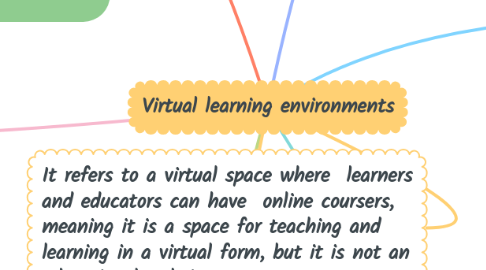
1. 2 A virtual learning environment is a social space
1.1. When we say “A virtual learning environment,” we should know when this term applies because if there is no social interaction using different online platforms, it is not a social environment. For example, if an educator just sends the link address to the students, and they just read it, the dynamic would not be considered as social space. However, it would be different if students interact sharing their opinions in a synchronous or asynchronous communication.
2. 3. The virtual space is explicitly represented
2.1. The representations of virtual spaces influences in students learning, what virtual educators track is how the virtual space catches learner's attention, despite the key is not how is being presented at all, but what students do with this information presented. This is the main idea that is why It is assumed that pleasant representations trigger positive attitudes toward the environment atmosphere.
3. 4. Students are not only active, but also actors
3.1. Using virtual environments spaces to learn make students are not only active, they also become actors by getting involved in different activities that allow them to create reports, online games, videos where they participate and others. This also helps students to engage their learning by thinking, discussing, investigating, and creating skills that allow them to participate as actors.
4. It refers to a virtual space where learners and educators can have online coursers, meaning it is a space for teaching and learning in a virtual form, but it is not an educational website or page.
5. 5. Virtual learning environments are not restricted to distance education.
5.1. It is common that every time people hear Web-based education, they associate it with distance education, however it is also useful to reinforce or support presential education. Currently, the difference between distance education and presential education is fading for several reasons:
5.1.1. Nowadays, many of the students decide studying Web-based education, because they have different responsibilities besides studying such as: work, family roles and others. So, using Asynchronous communication provides them time flexibility.
5.1.2. With students that assist to presential classes also use this type of virtual environments since this support their knowledge with different activities.
6. 7. Most virtual environments overlap with physical environments.
6.1. Virtual environment spaces are not only focus on activities online, the majority of Web-based education include similar activities as presential education, of course there are activities that are designed for a virtual environmental learning. But it includes activities such as: discussions face to face in pairs, or groups, lectures by teachers or plus traditional media such as: letters, TV, phone, and fax.
7. 6. Virtual learning environments integrate heterogeneous technologies and multiple pedagogical approaches
7.1. Virtual learning environments not only facilitate the education, it also supports synchronous and non-synchronous pedagogical approaches such as: managing who is registered to which courses,activities completed by students, grade, administrative information, and it also helps to provide support when it is requested by learners.
8. 1. A virtual learning environment is a designed information space.
8.1. All websites can be a space to learn, if those are used correctly but not all of them have been studied systematically, here are some examples:
8.1.1. • Using information in educational interactions: means the use of tools that allow educators and students to answer simple questions to produce dynamic interaction between both in an online platform.
8.1.2. • Multi-authoring: It allows educators and learners to share their own knowledge about the topic to discuss, this makes each learner share their own ideas through a virtual space.
8.1.3. • Maintaining information: to maintain the website, the information should be structured correctly since the beginning of the creation to avoid that the maintaining becomes heavy when this grows.
